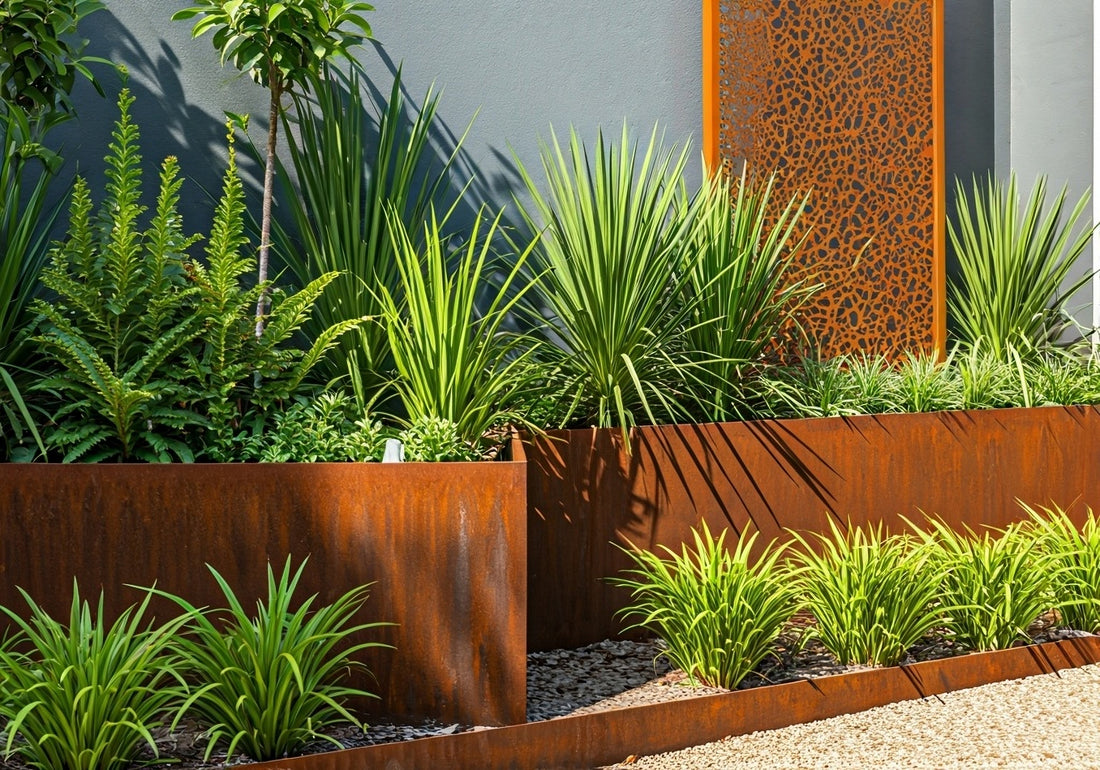
Corten Steel: What Arkus Industries Wants You to Know
Corten steel, also known as weathering steel, is increasingly popular in architectural, landscaping, and artistic metalwork applications in Australia. At Arkus Industries, we specialise in precision metal fabrication, and over time we’ve found that Corten steel delivers a compelling blend of aesthetics and durability. In this article, we’ll explain what Corten is, how it works, its pros and cons, best practices, and whether it’s right for your next project.
What is Corten Steel?
Corten is a steel alloy engineered to naturally develop a stable, rust-like patina when exposed to weather. Rather than allowing oxidation to degrade the metal, this outer oxide layer forms a protective barrier—limiting deeper corrosion. Over time, the surface “ripens” into rich earth tones while still protecting the structural core.
Originally designed for industrial use (like railroad coal wagons), its success led to broader adoption in outdoor sculpture, facades, garden structures and urban landscaping.
At Arkus Industries, we fabricate custom Corten components (screens, planters, features, structural elements) that balance aesthetic appeal and long-term performance.
Why Corten Steel Is Special
Protective patina formation — Unlike ordinary steel, Corten’s surface oxidation is self-limiting: after an initial rusting phase, further corrosion slows dramatically.
Low maintenance — Because the patina naturally re-forms after weathering, you rarely need to repaint or recoat.
Aged appearance that enhances over time — The warm, oxidised look blends beautifully into natural and architectural environments.
Structural integrity — With proper design and fabrication, Corten can be used in both decorative and load-bearing roles.
Composition & Grades of Corten Steel
Corten is enriched with elements like copper, chromium, nickel, phosphorus, and molybdenum, which help stabilise the rust layer and improve corrosion resistance.
Two common grades are:
Corten A — Lower in carbon and manganese; richer in phosphorus, copper, chromium. It’s well suited to artistic facades, screens and decorative elements.
Corten B — Higher in carbon and manganese, suited for structural or heavy load applications.
Depending on the grade, sheet thickness can range from ~1 mm up to ~12 mm for decorative plates, and thicker (15–50 mm) for heavy structural plates.
Benefits & Drawbacks
✅ Pros of Using Corten Steel
Long life span — Durable over decades if designed correctly
Excellent corrosion resistance — The protective oxide layer slows further rust
Weather-tolerance — Performs well under varying climatic conditions
Minimal upkeep — Occasional rinsing or light cleaning is generally sufficient
Aesthetically rich — No need for paint or finishes to achieve natural rustic tones
Sustainability — Recyclable at end of life; low long-term maintenance reduces resource use
⚠️ Drawbacks & Design Considerations
Moisture trap risk — Areas with pooling or constant dampness may not allow the patina to stabilise properly
Rust staining — During early weathering, runoff may stain adjacent surfaces (concrete, stone, pavers)
Unsuitable climates — In very humid or tropical settings, the patina layer may not form consistently
Welding challenges — Matching filler metals and techniques is essential to maintain uniform properties
Initial cost premium — Corten can cost more than plain steel, though savings in maintenance often offset that over time
Fabrication, Rusting & Maintenance Best Practices
Rusting Timeline
Under alternating wet/dry conditions, the patina typically matures over 18 to 36 months
In harsh environments or with less drying opportunities, full stabilisation can take 4 to 10 years
Accelerating Patina
To hasten the ageing process, controlled wet/dry cycling helps. Some fabricators gently mist salt solutions or vinegar mixtures to initiate oxidation—though this must be done carefully and uniformly.
Preventing Staining & Corrosion
Use drip edges or overhangs to redirect runoff
Flush adjacent surfaces during early weathering to remove residual rust
Seal or coat critical zones (e.g. underside, edges) if contact with concrete or stone is unavoidable
Sealing
If you wish to stop further patina development or reduce rust bleed, you can apply coatings such as polyurethane or proprietary metal sealants. However, this halts the characteristic ageing process, so you should decide whether you prefer natural evolution or a stabilised finish.
Routine Maintenance
Rinse with clean water to remove contaminants
Inspect for water pockets or damage
In extreme environments, periodic touchups or sealing may be warranted
Applications & Use Cases
At Arkus Industries, we use Corten steel for:
Landscape features (screens, trellises, garden edging, planter boxes)
Architectural facades and cladding
Sculptural installations in public or residential settings
Structural elements where rusted aesthetic is desired
It’s particularly effective in outdoor environments where changing moisture, sun and wind stimulate patina formation without constant saturation.
Is Corten Steel Right for You?
Here are some guiding questions:
-
Is the environmental exposure suitable? Coastal or constantly damp zones may inhibit stable patina formation.
-
Are you comfortable with early-stage rust bleed? Design to manage runoff and stain risk.
-
Do you prefer the natural weathered aesthetic? If you want to prevent rust entirely, another stainless or painted steel may be better.
-
Does your budget support higher upfront costs in exchange for lower long-term maintenance?
If your answer leans toward yes, then Corten is likely an excellent fit—and Arkus Industries can help you design and fabricate Corten systems that maximise performance and visual effect.
Why Choose Arkus Industries for Corten Projects?
Tailored design & engineering — We integrate corrosion modelling, load calculations, and aesthetic objectives
Precision fabrication — Laser cutting, bending, welding with quality control to preserve integrity
Local knowledge — We understand Australian climate zones, salt exposure, UV, and best practices here
End-to-end service — From concept and prototyping through finishing and installation
If you’re considering Corten steel for a façade, feature wall, garden installation or structural piece, Arkus Industries would welcome the opportunity to collaborate.
Contact us today to discuss how Corten can bring both beauty and longevity to your project.


